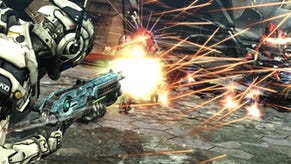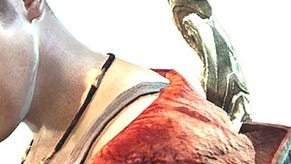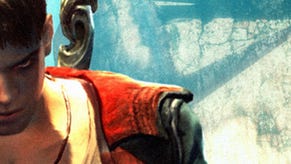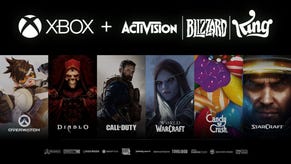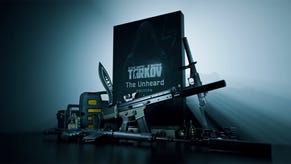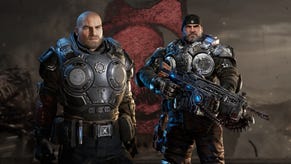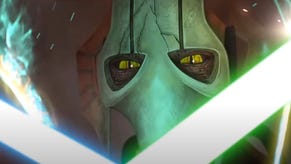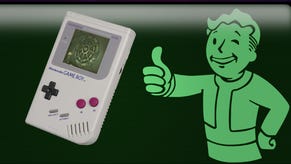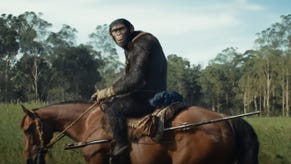Lost Planet 3: 'it's impossible to please everyone'
Lost Planet 3 is another venture between Capcom and a Western studio. VG247's Dave Cook speaks with the developer to find out why teaming up with Spark Unlimited is paying off.
Capcom is fond of dipping its big toe in the Western dev pool, even if an endless score of gamers seems to fall out with the Japanese giant each time it does so. We see almost daily barbs fired at Ninja Theory for its treatment of 'new Dante', and to a lesser extend we see occasional jibes about the direction of Lost Planet 3.
Compared to the colourful, frequently hilarious and almost arcade-like veneer of Lost Planet 2, Spark Unlimited's third instalment feels worlds away. You're no longer a faceless merc in a Japan-centric environment, you're Jim, a grizzled American working the frozen ice fields of E.D.N III to feed his family.
It's easy to see why gamers - particularly fans of the franchise are approaching the game with caution, but give it the time of day and you'll see that the series' staples are still there. Huge Akrid beasts, stomping mechs, gunplay and a seense of isolation all recall the first game in the series.
So to learn more about Lost Planet 3's risky about-face, VG247 caught up with Andrew Szymanski, Lost Planet 3's producer and project lead at Capcom, Tokyo.
VG247: Managing expectations in the games industry is tough. How wary were you of the way fans would react to the westernised tone of Lost Planet 3, and what sort of fan feedback have you had since you announced?
Andrew Szymanski: The key feedback we’ve received from members of the press and public, that have actually played our demos at E3 and at Gamescom, is that they really enjoy the new direction we're taking, and that they understand the concept. That concept is that we're keeping the core pillars of the Lost Planet franchise intact while arranging them in a new way.
Of course, there will always be core fans that really enjoyed the previous games in the series who may be concerned at the changes, particularly on the surface level. The important thing to note is that we have the Capcom Osaka franchise team that made the first two games helping to guide the process to make sure that it remains true to what fans expect.
The franchise fans are very important to us and I hope that they will understand why we are changing what we are in order to keep the franchise relevant and vibrant.

There's definitely a 'darker and with more facial hair' vibe going on.
This is becoming a wide-spread issue - not just with Capcom, but across the industry. There are a lot of studios currently balancing between classic franchise elements while trying to keep things feeling fresh in new instalments. How difficult is that to achieve?
It is a tricky balancing act. As you know it is impossible to please everyone. Change too much and fans may get upset; change too little and you are accused of letting things stagnate.
In a way we are lucky as Lost Planet as a franchise has a knack for re-inventing itself with each new instalment.
We’ve had the opportunity to do so again with Lost Planet 3 and, while going back to our roots in a certain sense - going back to a frozen world with a strong narrative for the campaign - we’ve also made sure to keep the core elements that make the franchise unique, including the large mechs, Akrid enemies, and multiple human factions.
I mean, it's clear that this is a risky prospect, no matter what series you work on, so how strongly did you have to pitch this partnership and new direction?
I can only comment on this from the Capcom side. When Kenji Oguro -who is game director for the first two games and is the current creative director - approached me regarding doing a third Lost Planet game, he already had many thoughts about the direction he wanted to take.
That was namely, focusing on the early colonisation efforts on the planet and the colonists’ struggles to survive in those conditions. Capcom then worked closely with the Spark creative leads to craft a joint vision for the game in which both sides built consensus. We felt this allowed Spark to bring their unique skills to the table while ensuring that the title retains the Lost Planet essence.
It does seem different in that it leans towards an almost survival horror tone at points. Are you going for a sustained sense of horror throughout the campaign or is this still largely an action title?
It’s still largely an action title, but as gamers ourselves we recognize that having balls-to-the-wall action non-stop throughout can actually cause each enemy encounter to feel less meaningful.
That’s one reason why we are focusing on exploration and the sense of isolation and adventure in the title, and one way of doing that is through the more suspense-driven interior base sections in the game.
We call these 'palate cleansers' internally, and they serve to highlight Jim’s trepidation at exploring an unknown environment and allow us to create a foreboding atmosphere inspired by the original 'Alien' film.

Piloting Jim's Rig switches the action to a first-person perspective.
Although you say it's still an action title throughout, Jim's Rig mech isn't weaponised with all the huge cannons, missile launchers, fans of Lost Planet 2 might remember. How does Jim's lack of readiness to face the Akrid factor into combat, gameplay and the plot?
It affects it in all areas, as the Lost Planet 3 mech - the Utility Rig - is designed as a piece of construction equipment, used to help build and maintain the colony. That’s exactly what Jim has been sent to the planet to do, and initially Jim, and the player, will be using it for that purpose.
Soon after arriving, however, Jim and the player will need to improvise to use the tools on the Rig to fight attacking Akrid. One of the key features of Lost Planet 3 is the dichotomy between being out of the Rig - in which Jim uses standard firearms - and inside of it. where Jim must use its construction tools to defeat enemies in melee combat.
We like that this turns standard convention on its head. Also, crushing giant insects with a massive drill never gets old [laughs].
What does the lack of weaponised Rigs mean for the wealth of different vehicles on offer? Will there be many types available this time around?
Well for the single-player campaign, Jim and the player will only be using one Rig. This is important as that Rig is Jim’s personal property and it factors in very heavily to the narrative. That is not to say that other mechs won’t appear piloted by other characters, however.
In terms of handling, the Rig is deliberately designed to be a huge, lumbering, tough, durable piece of machinery that is built to take the harsh conditions of the planet and keep on going and thus its abilities, upgrades, and attachments all keep that in mind.
So far we’ve shown the Claw Arm on the left side of the Rig that can be upgraded with a Winch to allow the claw to be shot out like a projectile, as well as the Drill Arm on the right side of the Rig that is, of course, used to destroy chunks of ice as well as fight Akrid. There are many more upgrades and attachments to be discovered.
Turning to Jim for a second, it's clear that Lost Planet 3 is more character-driven, while the characters in Lost Planet 2 were largely faceless. Why did you decide to make this a more personal story?
One of the things that we felt strongly going in to Lost Planet 3 was the idea of returning to our roots with a strong protagonist and a narrative-driven campaign. While Lost Planet 2 was very good at what it did well - namely, providing an almost 'party game' style of shooter - the feedback from both within Capcom and from the gaming public was that they wanted to know who their character was and why he was going what he was doing.
With that in mind we decided to become so focused on Jim’s story for the third instalment.
This does preclude co-op for the 'story mode' campaign. The story of Lost Planet 3 is all about Jim’s journey from the time he arrives on the planet until the eventual conclusion.
The narrative contains themes of struggle, loneliness, solitude, and redemption and we feel strongly that having a co-op 'clone' of Jim follow him everywhere would do a disservice to the narrative.

Would sights like this be as poignant with a second person shouting in the background? Perhaps not.
That's a shame that co-op won't feature in the campaign as multiplayer is a huge part of Lost Planet's DNA. You probably can't share specifics about what you're adding this time, but what staples do you absolutely have to retain this time around?
First, you are absolutely correct that Multiplayer is an integral part of the franchise DNA. While I can’t discuss details, I will say that when designing the various modes in the multiplayer suite we have focused on the three elements that make the Lost Planet franchise unique: multiple human factions, Akrid creatures, and giant machines. Figuring out how to bring all of these elements into the multiplayer has been very important to us.
Previously we've seen Japanese publishers enlisting Western studios to handle their long-standing IP and the typical reaction is one of cautious optimism. Do you feel we're now at a turning point where gamers need not worry?
I do believe that with DmC and with LP3, Capcom is showing that collaboration with Western developers can result in something that is more than the sum of its parts. Capcom as a whole has had a lot of experience both positive and negative in this area and I believe it is informing us well at this point.
The key is to remember that the goal is not to re-create these franchises part-and-parcel with another developer – that would defeat the whole purpose. Instead, we are attempting to breathe new life into Lost Planet by infusing it with sensibilities and strengths that would not have been available had the title stayed with the internal team exclusively.
You'd have to imagine that – with money being such an issue in today's industry, that publishers like Capcom don't make these decisions lightly, but should other publishers be encouraged to take this approach?
No game is perfect, and no method of planning exists to make things turn out perfectly. We plan the best that we can to make sure that the project runs smoothly, but we also understand that the unexpected will happen and creative spontaneity has to be allowed in order for ideas to flourish. I’m sure that all publishers have their own unique best practices in this area.
Just finally, Why has Capcom overlooked Wii U for Lost Planet 3?
I wouldn’t say that we’ve 'overlooked' it, as we are constantly evaluating our portfolio as a publisher and considering the best way to bring or games to multiple platforms. That being said, at the moment we are focus on delivering Lost Planet 3 for the platforms that we have already announced.f




